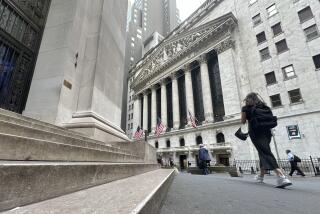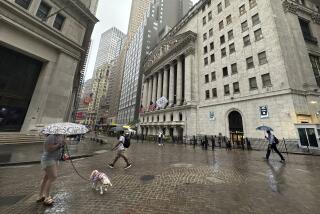Black Monday: Never again?
- Share via
NEW YORK — Ted Weisberg remembers the 1987 stock market crash like it was yesterday.
He had been a floor broker at the New York Stock Exchange for 18 years but had never seen the panic or billions of dollars in losses that occurred Oct. 19, 1987 -- 20 years ago this Friday -- as the Dow Jones industrial average tumbled 508 points, or 22.6%.
“You could feel, taste and touch the emotion,” Weisberg said of what soon became known as Black Monday. “That day clearly was different from any other day any of us had ever experienced.”
The decline remains by far the biggest one-day percentage drop in the Dow’s 111-year history.
Could it happen again?
That question is being asked by some, in part because of notable similarities between market conditions then and now. As in 1987, the dollar is weak, oil and commodity prices are rising, volatility is surging and stocks are in the fifth year of a bull market.
Many analysts say another one-day plunge is highly unlikely. Liz Ann Sonders, chief investment strategist at Charles Schwab Corp., calls the chances “infinitesimal.”
“There are a lot of similarities” between ’87 and ‘07, she said. But “there are important differences too.”
Indeed, the financial markets have undergone a tremendous transformation in the last two decades, growing enormously and becoming globalized. And thanks to technology, the volume and speed of trading have soared.
It is the reliance on technology that bothers experts who see disturbing parallels between a computer-aided trading strategy used in 1987 and the computer-driven trading of today’s “quantitative” hedge funds.
The 1987 sell-off was fueled in part by “portfolio insurance,” a strategy used by large institutions in hopes of minimizing losses. But as stocks began sliding on Black Monday, the institutions’ computers sold stock-index futures, which only magnified the selling pressure.
This summer, during the market sell-off triggered by the sub-prime mortgage meltdown and resulting credit crunch, some quantitative funds suffered deep losses in part because they followed similar trading strategies and were simultaneously trying to sell many of the same stocks.
“When all these computers head for the exit at the same time and everybody is doing the same thing, that’s how you get a crash,” said Tony Kolton, chief executive of MarketHistory.com.
That kind of risk might be even greater now because of the rise of increasingly exotic securities such as mortgage-backed bonds, which were at the heart of this year’s credit woes.
On the other hand, bulls cite several factors that make a repeat of 1987 unlikely.
A key difference between the two eras is that the stock market was clearly frothy back then, Charles Schwab’s Sonders said. Share prices had soared that year, stretching the market’s valuations.
In 1987, the Dow gained 44% from the start of the year to its late-August peak. The index is up less than 12% this year.
In 1987, to create a portfolio mirroring the Standard & Poor’s 500 index, you had to pay about 23 times the 500 stocks’ earnings over the previous four quarters, Sonders said.
Today, the index’s stocks go for a much more affordable 18 times earnings.
Investor sentiment is also more subdued now than it was in 1987.
“Those are pretty big differences,” said Tobias Levkovich, chief U.S. equity strategist at Citi Investment Research.
In addition, in 1987 the Federal Reserve was raising interest rates, which is rarely good for stocks, to ward off inflation.
But today, inflation excluding food and energy prices is much lower than 20 years ago and the central bank cut rates last month in hopes of alleviating the credit crunch.
For individual investors, the markets have become more accessible because researching and trading stocks is far easier and cheaper than two decades ago and because employee-managed retirement accounts such as 401(k) plans are now commonplace.
As a result, Americans are much more exposed to the stock market. In 2005, 50% of American households had some type of stock exposure, compared with 32% in 1989, according to the Securities Industry and Financial Markets Assn.
“It used to be a preoccupation with some people, and now it’s embedded in the culture,” said Charles Geisst, a finance professor at Manhattan College.
Two things that haven’t changed are the key financial emotions: greed and fear. Investors who piled on debt to boost their already healthy returns suffered heavy losses in 1987, which were made worse when they panicked, traders said.
Therein lies a lesson for individual investors, said Weisberg, who’s still working the trading floor as president of Seaport Securities Corp.
“It teaches you to try to remove yourself from emotional decision-making, at least when it comes to buying and selling stocks,” he said.
Another message: After you notch big gains in a part of your portfolio, make sure that you’re not overexposed to that sector, Sonders said.
“The lesson to be learned is, ‘Don’t get greedy,’ ” she said.
Kolton, a former trader who worked on the floor of the Chicago Board Options Exchange in 1987, remembers a fellow trader who had lost a huge sum on risky bets.
At the end of the day, Kolton said, “he wanted to sell me his pager because he said that was the only asset he had left.”
More to Read
Inside the business of entertainment
The Wide Shot brings you news, analysis and insights on everything from streaming wars to production — and what it all means for the future.
You may occasionally receive promotional content from the Los Angeles Times.










